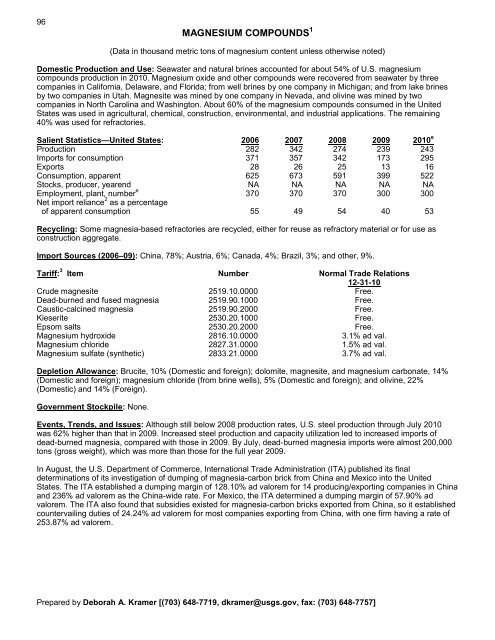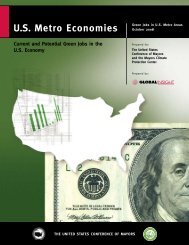LITHIUM95market, <strong>and</strong> a facility at a brine deposit in Argentina produced lithium carbonate <strong>and</strong> lithium chloride. Two additionalbrine operations were under development in Argentina. Worldwide, most lithium minerals mined were used directly asore concentrates in ceramics <strong>and</strong> glass applications rather than as feedstock for lithium carbonate <strong>and</strong> other lithiumcompounds.In an effort to increase the quality of lithium suitable for advanced transportation batteries, the sole active lithiumproduction company in United States began the expansion of its lithium operation in North Carolina to include batterygradelithium hydroxide. Funding for the project was obtained in part from the U.S. Department of <strong>Energy</strong>. Anemerging Australian lithium ore producer commenced lithium concentrate production in Western Australia. The lithiumconcentrate was to be converted to battery-grade lithium carbonate in China to supply the Asian market. Australia’sleading lithium ore miner merged with an emerging lithium brine mining company to develop a lithium brine operationin Chile.Batteries, especially rechargeable batteries, are the uses for lithium compounds with the largest growth potential.Dem<strong>and</strong> for rechargeable lithium batteries continued to gain market share over rechargeable nonlithium batteries foruse in cordless tools, portable computers <strong>and</strong> cellular telephones, <strong>and</strong> video cameras. Major automobile companieswere pursuing the development of lithium batteries for hybrid electric vehicles—vehicles with an internal combustionengine <strong>and</strong> a battery-powered electric motor. Most commercially available hybrid vehicles use other types ofbatteries, although future generations of these vehicles may use lithium. Nonrechargeable lithium batteries were usedin calculators, cameras, computers, electronic games, watches, <strong>and</strong> other devices.Asian technology companies continued to invest in the development of lithium operations in other countries to ensurea stable supply of lithium for their battery industries. With lithium carbonate being one of the lowest cost componentsof a lithium-ion battery, the issue to be addressed was not cost difference or production efficiency but supply securityattained by acquiring lithium from a number of different lithium sources.World Mine Production <strong>and</strong> Reserves: Reserves estimates for Argentina, Brazil, Canada, China, <strong>and</strong> Portugal havebeen revised based on new information from Government <strong>and</strong> industry sources.Mine production Reserves 22009 2010 eUnited States W W 38,000Argentina 2,220 2,900 850,000Australia 6,280 8,500 580,000Brazil 160 180 64,000Canada 310 — —Chile 5,620 8,800 7,500,000China 3,760 4,500 3,500,000Portugal — — 10,000Zimbabwe 400 47023,000World total (rounded) 3 18,800 3 25,300 13,000,000World Resources: The identified lithium resources total 4 million tons in the United States <strong>and</strong> approximately 29million tons in other countries. Among the other countries, identified lithium resources for Bolivia <strong>and</strong> Chile total 9million tons <strong>and</strong> in excess of 7.5 million tons, respectively. China <strong>and</strong> Argentina total 5.4 million tons <strong>and</strong> 2.6 milliontons of identified lithium resources, respectively, while Brazil, Congo, <strong>and</strong> Serbia each contain approximately 1 milliontons. Identified lithium resources for Australia <strong>and</strong> Canada total 630,000 tons <strong>and</strong> 360,000 tons, respectively.Substitutes: Substitution for lithium compounds is possible in batteries, ceramics, greases, <strong>and</strong> manufactured glass.Examples are calcium <strong>and</strong> aluminum soaps as substitutes for stearates in greases; calcium, magnesium, mercury,<strong>and</strong> zinc as anode material in primary batteries; <strong>and</strong> sodic <strong>and</strong> potassic fluxes in ceramics <strong>and</strong> glass manufacture.Lithium carbonate is not considered to be an essential ingredient in aluminum potlines. Substitutes for aluminumlithiumalloys in structural materials are composite materials consisting of boron, glass, or polymer fibers inengineering resinse Estimated. W Withheld to avoid disclosing company proprietary data. — Zero.1 Defined as imports – exports + adjustments for Government <strong>and</strong> industry stock changes.2 See Appendix C for resource/reserve definitions <strong>and</strong> information concerning data sources.3 Excludes U.S. production.U.S. Geological Survey, <strong>Mineral</strong> <strong>Commodity</strong> <strong>Summaries</strong>, January <strong>2011</strong>
96MAGNESIUM COMPOUNDS 1(Data in thous<strong>and</strong> metric tons of magnesium content unless otherwise noted)Domestic Production <strong>and</strong> Use: Seawater <strong>and</strong> natural brines accounted for about 54% of U.S. magnesiumcompounds production in 2010. Magnesium oxide <strong>and</strong> other compounds were recovered from seawater by threecompanies in California, Delaware, <strong>and</strong> Florida; from well brines by one company in Michigan; <strong>and</strong> from lake brinesby two companies in Utah. Magnesite was mined by one company in Nevada, <strong>and</strong> olivine was mined by twocompanies in North Carolina <strong>and</strong> Washington. About 60% of the magnesium compounds consumed in the UnitedStates was used in agricultural, chemical, construction, environmental, <strong>and</strong> industrial applications. The remaining40% was used for refractories.Salient Statistics—United States: 2006 2007 2008 2009 2010 eProduction 282 342 274 239 243Imports for consumption 371 357 342 173 295Exports 28 26 25 13 16Consumption, apparent 625 673 591 399 522Stocks, producer, yearend NA NA NA NA NAEmployment, plant, number e 370 370 370 300 300Net import reliance 2 as a percentageof apparent consumption 55 49 54 40 53Recycling: Some magnesia-based refractories are recycled, either for reuse as refractory material or for use asconstruction aggregate.Import Sources (2006–09): China, 78%; Austria, 6%; Canada, 4%; Brazil, 3%; <strong>and</strong> other, 9%.Tariff: 3 Item Number Normal Trade Relations12-31-10Crude magnesite 2519.10.0000 Free.Dead-burned <strong>and</strong> fused magnesia 2519.90.1000 Free.Caustic-calcined magnesia 2519.90.2000 Free.Kieserite 2530.20.1000 Free.Epsom salts 2530.20.2000 Free.Magnesium hydroxide 2816.10.0000 3.1% ad val.Magnesium chloride 2827.31.0000 1.5% ad val.Magnesium sulfate (synthetic) 2833.21.0000 3.7% ad val.Depletion Allowance: Brucite, 10% (Domestic <strong>and</strong> foreign); dolomite, magnesite, <strong>and</strong> magnesium carbonate, 14%(Domestic <strong>and</strong> foreign); magnesium chloride (from brine wells), 5% (Domestic <strong>and</strong> foreign); <strong>and</strong> olivine, 22%(Domestic) <strong>and</strong> 14% (Foreign).Government Stockpile: None.Events, Trends, <strong>and</strong> Issues: Although still below 2008 production rates, U.S. steel production through July 2010was 62% higher than that in 2009. Increased steel production <strong>and</strong> capacity utilization led to increased imports ofdead-burned magnesia, compared with those in 2009. By July, dead-burned magnesia imports were almost 200,000tons (gross weight), which was more than those for the full year 2009.In August, the U.S. Department of Commerce, International Trade Administration (ITA) published its finaldeterminations of its investigation of dumping of magnesia-carbon brick from China <strong>and</strong> Mexico into the UnitedStates. The ITA established a dumping margin of 128.10% ad valorem for 14 producing/exporting companies in China<strong>and</strong> 236% ad valorem as the China-wide rate. For Mexico, the ITA determined a dumping margin of 57.90% advalorem. The ITA also found that subsidies existed for magnesia-carbon bricks exported from China, so it establishedcountervailing duties of 24.24% ad valorem for most companies exporting from China, with one firm having a rate of253.87% ad valorem.Prepared by Deborah A. Kramer [(703) 648-7719, dkramer@usgs.gov, fax: (703) 648-7757]
- Page 3:
U.S. Department of the InteriorKEN
- Page 6 and 7:
INTRODUCTION3Each chapter of the 20
- Page 8 and 9:
5NET EXPORTS OF MINERALRAW MATERIAL
- Page 10 and 11:
SIGNIFICANT EVENTS, TRENDS, AND ISS
- Page 12 and 13:
mineral materials valued at $1.30 b
- Page 14 and 15:
11MAJOR METAL-PRODUCING AREASAuB2P1
- Page 16 and 17:
13MAJOR INDUSTRIAL MINERAL-PRODUCIN
- Page 18 and 19:
ABRASIVES (MANUFACTURED)15Events, T
- Page 20 and 21:
ALUMINUM17The United States continu
- Page 22 and 23:
ANTIMONY19Events, Trends, and Issue
- Page 24 and 25:
ARSENIC21According to university me
- Page 26 and 27:
ASBESTOS23Events, Trends, and Issue
- Page 28 and 29:
BARITE25Nationally, the rig count o
- Page 30 and 31:
BAUXITE AND ALUMINA27Events, Trends
- Page 32 and 33:
BERYLLIUM29Events, Trends, and Issu
- Page 34 and 35:
BISMUTH31Events, Trends, and Issues
- Page 36 and 37:
BORON33Events, Trends, and Issues:
- Page 38 and 39:
BROMINE35Events, Trends, and Issues
- Page 40 and 41:
CADMIUM37NiCd battery use in consum
- Page 42 and 43:
CEMENT39The manufacture of clinker
- Page 44 and 45:
CESIUM41Events, Trends, and Issues:
- Page 46 and 47:
CHROMIUM43Stockpile Status—9-30-1
- Page 48 and 49: CLAYS45Tariff: Item Number Normal T
- Page 50 and 51: COBALT47Events, Trends, and Issues:
- Page 52 and 53: COPPER49Events, Trends, and Issues:
- Page 54 and 55: DIAMOND (INDUSTRIAL)51Events, Trend
- Page 56 and 57: DIATOMITE53Events, Trends, and Issu
- Page 58 and 59: FELDSPAR55Feldspar use in tile and
- Page 60 and 61: FLUORSPAR57with planned output of 1
- Page 62 and 63: GALLIUM59In response to the unprece
- Page 64 and 65: GARNET (INDUSTRIAL)61Events, Trends
- Page 66 and 67: GEMSTONES63Events, Trends, and Issu
- Page 68 and 69: GERMANIUM65Events, Trends, and Issu
- Page 70 and 71: GOLD67With the increase in price of
- Page 72 and 73: GRAPHITE (NATURAL)69Events, Trends,
- Page 74 and 75: GYPSUM71Through 2010, more than 3,6
- Page 76 and 77: HELIUM73Events, Trends, and Issues:
- Page 78 and 79: INDIUM75China’s 21 indium produce
- Page 80 and 81: IODINE77Events, Trends, and Issues:
- Page 82 and 83: IRON AND STEEL79Events, Trends, and
- Page 84 and 85: IRON AND STEEL SCRAP81Tariff: Item
- Page 86 and 87: IRON AND STEEL SLAG83Events, Trends
- Page 88 and 89: IRON ORE85In 2009, China imported a
- Page 90 and 91: IRON OXIDE PIGMENTS87Events, Trends
- Page 92 and 93: KYANITE AND RELATED MATERIALS89Even
- Page 94 and 95: LEAD91caused by underground fires a
- Page 96 and 97: LIME93The lime industry is facing p
- Page 100 and 101: MAGNESIUM COMPOUNDS97In Australia,
- Page 102 and 103: MAGNESIUM METAL99U.S. magnesium con
- Page 104 and 105: MANGANESE101Government Stockpile:St
- Page 106 and 107: MERCURY103Events, Trends, and Issue
- Page 108 and 109: MICA (NATURAL)105Depletion Allowanc
- Page 110 and 111: MOLYBDENUM107Events, Trends, and Is
- Page 112 and 113: NICKEL109Nickel prices were adverse
- Page 114 and 115: NIOBIUM (COLUMBIUM)111Events, Trend
- Page 116 and 117: NITROGEN (FIXED)—AMMONIA113Accord
- Page 118 and 119: PEAT115Events, Trends, and Issues:
- Page 120 and 121: PERLITE117Events, Trends, and Issue
- Page 122 and 123: PHOSPHATE ROCK119Events, Trends, an
- Page 124 and 125: PLATINUM-GROUP METALS121Events, Tre
- Page 126 and 127: POTASH123Events, Trends, and Issues
- Page 128 and 129: PUMICE AND PUMICITE125Events, Trend
- Page 130 and 131: QUARTZ CRYSTAL (INDUSTRIAL)127Event
- Page 132 and 133: RARE EARTHS129Events, Trends, and I
- Page 134 and 135: RHENIUM131Events, Trends, and Issue
- Page 136 and 137: RUBIDIUM133Events, Trends, and Issu
- Page 138 and 139: SALT135Many chefs have advocated us
- Page 140 and 141: SAND AND GRAVEL (CONSTRUCTION)137Ev
- Page 142 and 143: SAND AND GRAVEL (INDUSTRIAL)139The
- Page 144 and 145: SCANDIUM141Scandium’s use in meta
- Page 146 and 147: SELENIUM143Events, Trends, and Issu
- Page 148 and 149:
SILICON145Events, Trends, and Issue
- Page 150 and 151:
SILVER147Silver was used as a repla
- Page 152 and 153:
SODA ASH149A Wyoming soda ash produ
- Page 154 and 155:
SODIUM SULFATE151Events, Trends, an
- Page 156 and 157:
STONE (CRUSHED)153Events, Trends, a
- Page 158 and 159:
STONE (DIMENSION)155Events, Trends,
- Page 160 and 161:
STRONTIUM157Events, Trends, and Iss
- Page 162 and 163:
SULFUR159World sulfur production in
- Page 164 and 165:
TALC AND PYROPHYLLITE161Events, Tre
- Page 166 and 167:
TANTALUM163Events, Trends, and Issu
- Page 168 and 169:
TELLURIUM165Events, Trends, and Iss
- Page 170:
THALLIUM167Beginning in 2009, there
- Page 173 and 174:
170TIN(Data in metric tons of tin c
- Page 175 and 176:
172TITANIUM AND TITANIUM DIOXIDE 1(
- Page 177 and 178:
174TITANIUM MINERAL CONCENTRATES 1(
- Page 179 and 180:
176TUNGSTEN(Data in metric tons of
- Page 181 and 182:
178VANADIUM(Data in metric tons of
- Page 183 and 184:
180VERMICULITE(Data in thousand met
- Page 185 and 186:
182WOLLASTONITE(Data in metric tons
- Page 187 and 188:
184YTTRIUM 1(Data in metric tons of
- Page 189 and 190:
186ZEOLITES (NATURAL)(Data in metri
- Page 191 and 192:
188ZINC(Data in thousand metric ton
- Page 193 and 194:
190ZIRCONIUM AND HAFNIUM(Data in me
- Page 195 and 196:
192APPENDIX AAbbreviations and Unit
- Page 197 and 198:
194Demonstrated.—A term for the s
- Page 199 and 200:
196Part B—Sources of Reserves Dat
- Page 201:
198Europe and Central Eurasia—con







